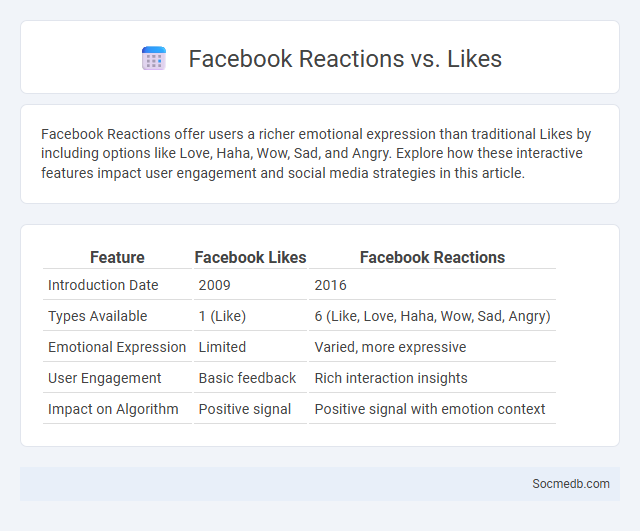
Photo illustration: Facebook Reactions vs Likes
Facebook Reactions offer users a richer emotional expression than traditional Likes by including options like Love, Haha, Wow, Sad, and Angry. Explore how these interactive features impact user engagement and social media strategies in this article.
Table of Comparison
| Feature | Facebook Likes | Facebook Reactions |
|---|---|---|
| Introduction Date | 2009 | 2016 |
| Types Available | 1 (Like) | 6 (Like, Love, Haha, Wow, Sad, Angry) |
| Emotional Expression | Limited | Varied, more expressive |
| User Engagement | Basic feedback | Rich interaction insights |
| Impact on Algorithm | Positive signal | Positive signal with emotion context |
Introduction to Facebook Engagement Features
Facebook engagement features include reactions, comments, shares, and retweets that boost interaction with your posts and increase visibility on the platform. Utilizing Facebook's interactive tools, such as polls, live videos, and stories, enhances user participation and fosters community building. You can leverage these features to build stronger connections with your audience and improve overall social media performance.
What Are Facebook Likes?
Facebook Likes represent a user's positive interaction with posts, pages, or comments, signaling approval or interest. These likes serve as social proof, increasing content visibility through Facebook's algorithm and enhancing your page's credibility. You can leverage Facebook Likes to gauge audience engagement and tailor your content strategy effectively.
Understanding Facebook Reactions
Facebook Reactions provide a range of emotive responses beyond the traditional like, including love, laughter, surprise, sadness, and anger, enabling users to convey nuanced feelings about posts. These Reactions enhance user engagement by offering deeper insight into audience sentiment, allowing content creators to better gauge the impact of their posts. By understanding how Your audience interacts through Facebook Reactions, you can tailor content to boost connection and engagement effectively.
The Role of Comment Threads
Comment threads on social media serve as dynamic hubs for user interaction, enabling rich conversations and diverse viewpoints that enhance content engagement. These threads increase visibility through algorithmic prioritization based on interaction volume and sentiment, driving organic reach and community growth. Moderation tools within comment sections promote respectful discourse, mitigating misinformation while fostering authentic user connections and brand loyalty.
Emotional Impact: Reactions vs. Likes
Emotional impact on social media is heightened by reactions, which convey nuanced feelings beyond simple likes, enabling users to express empathy, anger, joy, or surprise with specific emoji options. Research indicates that posts receiving varied reactions generate deeper engagement and emotional resonance compared to those with only likes, influencing user behavior and content virality. Platforms like Facebook and Instagram leverage this differentiation to enhance user experience and provide richer feedback metrics for content creators.
Engagement Metrics: Likes, Reactions, and Comments
Engagement metrics such as likes, reactions, and comments serve as key indicators of audience interaction and content effectiveness on social media platforms. Likes and reactions provide quick feedback on user sentiment, while comments offer deeper insights into audience opinions and foster community dialogue. Tracking these metrics helps brands optimize content strategies, increase reach, and build stronger user connections.
Algorithm Influence: How Each Affects Reach
Social media algorithms prioritize content based on user engagement, relevance, and recency, significantly shaping your content's reach and visibility. Platforms like Facebook utilize engagement signals such as likes, comments, and shares, while Instagram favors timely and interaction-rich posts to appear on your followers' feeds. Understanding these algorithmic preferences enables you to optimize content strategies to maximize organic reach and audience interaction.
User Intent Behind Each Action
Understanding the user intent behind each action on social media is crucial for creating targeted content and enhancing engagement metrics. Users typically interact with posts to seek information, express opinions, or connect with communities, reflecting diverse motivations such as entertainment, education, or social validation. By aligning Your social media strategy with these underlying intents, you can deliver more personalized experiences that drive meaningful interactions and foster brand loyalty.
Best Practices for Maximizing Engagement
To maximize engagement on social media, focus on creating high-quality, relevant content tailored to Your target audience's interests and needs. Use consistent posting schedules, utilize compelling visuals, and encourage interaction through questions, polls, and calls to action. Analyze platform-specific metrics regularly to optimize content performance and refine Your strategy for better reach and user involvement.
Choosing the Right Engagement Strategy
Successful social media engagement strategies prioritize audience analysis to tailor content that resonates with target demographics, increasing interaction rates and fostering brand loyalty. Utilizing data-driven insights from platform analytics enables marketers to refine posting schedules, content formats, and messaging techniques to optimize reach and engagement. Strategic integration of interactive features such as polls, live videos, and user-generated content campaigns enhances community participation and drives meaningful conversations around the brand.
 socmedb.com
socmedb.com